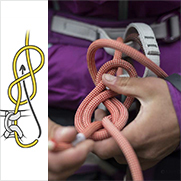Seoul: Groupe F lights up Lotte World Tower
On April 2, 2017, in Seoul, South Korea, the official inauguration was held for one of the world's tallest buildings, Lotte World Tower. Thousands of South Koreans enjoyed watching fireworks above the 550-meter high skyscraper. The French company, Groupe F, a fireworks specialist, made the show possible. Eric Fauroux, head of high-rise installations for Groupe F, talks to us about this one-of-a-kind work site.
June 14 2017
Rope access and confined space
Ivan making his way back up the building after installing fireworks.
Who is Groupe F? For how long have worked in pyrotechnics-at-height?
"Groupe F has been a pioneer in installing fireworks displays on tall buildings. The first project was New Year's Eve 2000 on the Eiffel Tower. Since then, we have taken on many other challenges, including the first four fireworks displays for Burj Khalifa in Dubai (828m), as well as on Tapei 101 (509m), during the ceremonies for the Rio Olympic Games, and on the Eiffel Tower for July 14th celebrations over the past few years."
Jaw-dropping exposure 500m up the side of the building!
How did you approach this particular site?
"As with all fireworks that we rig on skyscrapers, the access and attachment systems we design are specific to the building and to the pyrotechnic show.
For this particular tower, we installed 6 vertical firing lines. Each of the lines was 430m high and divided in to three sections: 50m, 180m, and 200m. All in all, we installed 536 firing points.
There are several challenges to manage when rigging this type of installation:
- Working at night, in the cold, and in bad weather,
- Setting up large enough safety zones on the ground in an urban environment,
- Height,
- The length of rope required, up to 200-meter long ropes for this tower,
- And the site's greatest challenge: our rope access team having to ascend 200 meters of rope to reach the low point of our fireworks rig since there was no access from inside the building.
Rigging the entire system required 8km of rope, 2000 carabiners, and 4km of electrical wiring. A team of 29 rope access professionals worked every night for two weeks to set everything up. It took only four nights to take everything down. The weather was nice to us this time around…
Of course, we have to prevent even the smallest of objects from falling. This is why the entire rigging and attachment system design revolves around limiting as much as possible this eventuality. Work would stop immediately if something fell."
Bob pays careful attention not to bump his firing plate.
What were the most memorable moments during this particular setup?
"One of the most important moments is confirming that all of the access and attachment systems we had developed and imagined over the course of several weeks actually work… But the most spectacular moment is always launching the fireworks display itself."
Testing the firing system before the show.
How do you organize the work site?
"Every project starts with a site visit during which we imagine, or rather 'dream up' what we plan to try… Between this visit and the first launch, we spend several intense weeks testing, making the fireworks and launching systems, scheduling, filing the safety plan, and finalizing all operational procedures. This continues until we head to the site itself. Whatever happens, we have to be ready when the big day arrives!"
Each object has its place; staying focused is the name of the game! Here, Max and Eric pick up a firing plate.
Who are your rope access professionals? Do they have a specific set of skills?
"The team of rope access professionals who work on our fireworks displays consists of individuals involved in both training and developing rope access techniques. For example, several of them help organize the French Rope Access Championships and the Petzl RopeTrip. Most are instructors in a wide variety of outdoor sports: caving guides, members of caving search and rescue teams in France, climbing instructors, and mountain guides. With teams like this, each site feels more like an expedition!
For this type of rigging, experience and being self-sufficient are extremely important. Even if there are several teams, most of the work is done in small groups of 3 or 4 people who are relatively autonomous.
Our rigs require moving up and down a lot on ropes. A harness like the FALCON ASCENT perfectly fits our needs. The latest version is extremely comfortable, without the need for a seat harness. Another important aspect is hoisting everything. So of course, pulleys like the PRO TRAXION are extremely useful."
Cédric and Jacques start their descent. Proper teamwork, coordination, and communication are all key to staying safe.
Do you have anything else you'd like to say?
"For more than 17 years we have enjoyed lighting up world-renowned buildings and monuments, and we hope that the fun will continue for years to come!"
Fred remains focused before the show starts.
Related News








